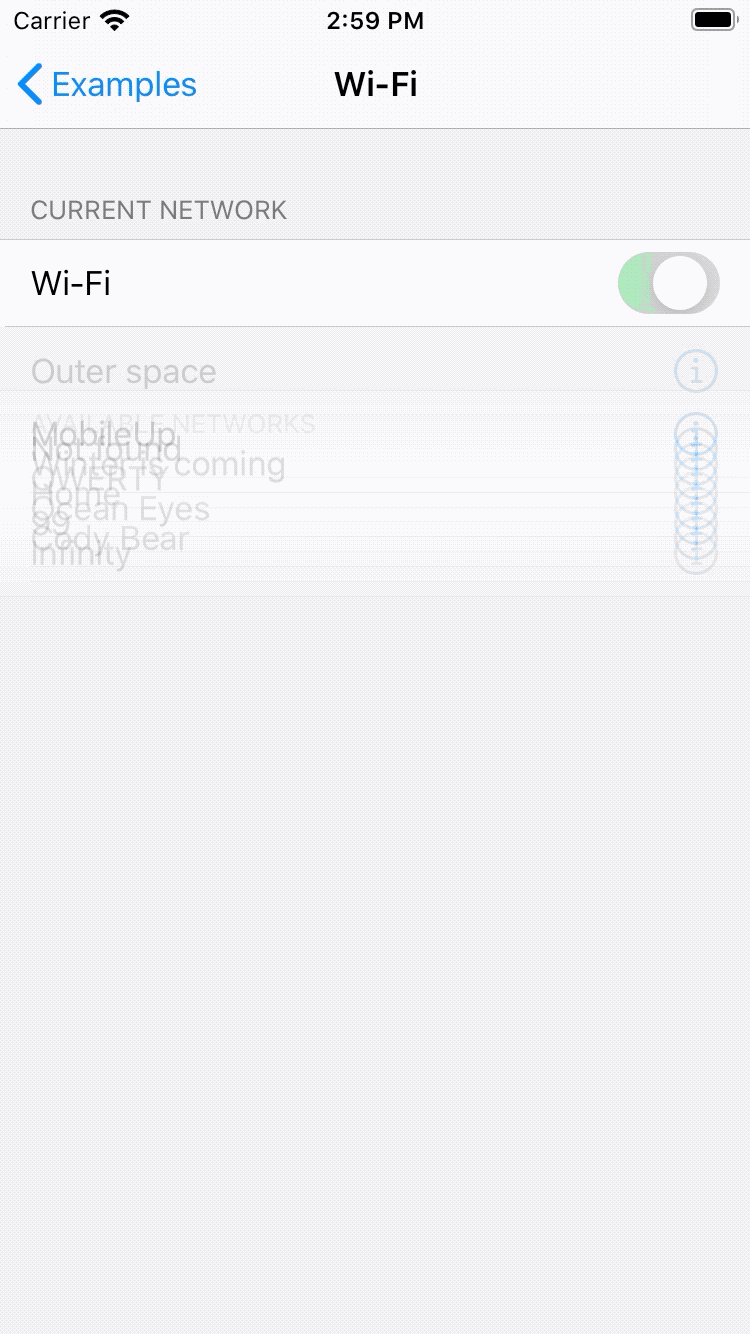
Ketika bekerja dengan, UITableViewsaya ingin menghindari penulisan kode templat, yang bahkan lebih rumit jika Anda perlu memperbarui keadaan tabel secara animasi. Apple mempresentasikan solusinya untuk masalah ini di WWDC 2019, tetapi hanya bekerja dengan iOS 13. Dan kami, sebagai studio pengembangan aplikasi mobile, tidak memiliki kemewahan untuk memilih versi minimum iOS.
Oleh karena itu, kami menyadari visi kami tentang pendekatan berbasis data untuk bekerja dengan tabel, sambil menyederhanakan konfigurasi sel di sepanjang jalan. Dan mereka menambahkan pembaruan tabel animasi, yang didasarkan pada perhitungan otomatis perbedaan antara data lama dan baru untuk waktu linier O (n) . Semua ini kami rancang menjadi perpustakaan kecil bernama TableAdapter.
Apa yang kami lakukan dan bagaimana kami sampai pada hal ini akan dibahas dalam artikel.
Pro dan Kontra TableAdapter
pro
- Pembaruan tabel animasi
- Perhitungan perbedaan otomatis dalam waktu linier
- Tidak perlu mewarisi tabel, sel, atau model
- Tidak lagi
dequeReusable... - Pengaturan sel yang aman, header / footer
- Inisialisasi sel dengan cara apa pun
- Penyiapan bagian yang mudah
- Mudah diperluas
Minus
, Hashable. , - Swift, .. . - .
– :
1. , /
1.1
, , Hashable.
extension User: Hashable { ... }
1.2
Configurable, . , .
extension Cell: Configurable {
public func setup(with item: User) {
textLabel?.text = item.name
}
}
, , , . , setup(with:) .
1.3 /
/ Configurable, . / 1.3 .
2.
() , /. Section<Item, SectionId>, (Item) (SectionId). (id) Hashable, .
/
/ header/footer.
/
/ headerIdentifier/footerIdentifier, . , Configurable ( 1.3).
let section = Section<User, Int>(
id: 0,
items: users,
header: "Users Section",
footer: "Users Section",
headerIdentifier: "HeaderReuseIdentifier",
footerIdentifier: "FooterReuseIdentifier"
)
id .
3.
TableAdapter<Item, SectionId>, (Item) (SectionId). , .
CellReuseIdentifierProvider, . , IndexPath , .
ellDidSelectHandler, , IndexPath .
lazy var adapter = TableAdapter<User, Int>(
tableView: tableView,
cellIdentifierProvider: { (indexPath, item) -> String? in
},
cellDidSelectHandler: { [weak self] (table, indexPath, item) in
}
)
:
adapter.update(with: [section], animated: true)
class ViewController: UIViewController {
let tableView = ...
lazy var adapter = TableAdapter<User, Int>(
tableView: tableView,
cellIdentifierProvider: { (indexPath, item) -> String? in
return "CellReuseIdentifier"
},
cellDidSelectHandler: { [weak self] (table, indexPath, item) in
}
)
let users: [User] = [...]
override func viewDidLoad() {
super.viewDidLoad()
setupTable()
let section = Section<User, Int>(
id: 0,
items: users,
header: "Users Section",
footer: "Users Section",
headerIdentifier: "HeaderReuseIdentifier",
footerIdentifier: "FooterReuseIdentifier"
)
adapter.update(with: [section]], animated: true)
}
func setupTable() {
tableView.register(
Cell.self,
forCellReuseIdentifier: "CellReuseIdentifier"
)
tableView.register(
Header.self,
forHeaderFooterViewReuseIdentifier identifier: "HeaderReuseIdentifier"
)
tableView.register(
Footer.self,
forHeaderFooterViewReuseIdentifier identifier: "FooterReuseIdentifier"
)
}
}
Hashable , (associated value).
, CellReuserIdentifierProvider. A , "Cell" :
tableView.register(
Cell.self,
forCellReuseIdentifier: adapter.defaultCellIdentifier
)
/
headerIdentifier/footerIdentifier . / , "Header"/"Footer".
tableView.register(
HeaderView.self,
forHeaderFooterViewReuseIdentifier identifier: adapter.defaultHeaderIdentifier
)
tableView.register(
FooterView.self,
forHeaderFooterViewReuseIdentifier identifier: adapter.defaultFooterIdentifier
)
Sender
, , , , TableAdapter'a sender. , / SenderConfigurable.
class ViewController: UIViewController {
lazy var adapter = TableAdapter<User, Int>(
tableView: tableView,
sender: self
)
}
extension Cell: SenderConfigurable {
func setup(with item: User, sender: ViewController) {
textLabel?.text = item.name
delegate = sender
}
}
: , . , setup(with:sender:) .
, CellProvider, :
lazy var adapter = TableAdapter<User, Int>(
tableView: tableView,
cellProvider: { (table, indexPath, user) in
let cell = table.dequeueReusableCell(
withIdentifier: "CellReuseIdentifier",
for: indexPath
) as! Cell
cell.setup(with: user)
return cell
}
)
/ TableAdapter .
(diff) , . , A technique for isolating differences between files. O(n) . Hashable.
, , performBatchUpdates(_:completion:) . . .
- () (id). .
let sectionsDiff = try calculateDiff(form: oldSections, to: newSections)
- , , . , , id. , , , . , , .
let intermediateSections = applyDiff(sectionsDiff, to: oldSections)
- ( id) . . , , .
let rowsDiff = try calculateRowsDiff(from: intermediateSections, to: newSections)
:
let diff = Diff(
sections: sectionsDiff,
rows: rowsDiff,
intermediateData: intermediateSections,
resultData: newSections
)
- : ( ) , .
data = diff.intermediateData
tableView.insertSections(diff.sections.inserts, with: animationType)
tableView.deleteSections(diff.sections.deletes, with: animationType)
diff.sections.moves.forEach { tableView.moveSection($0.from, toSection: $0.to) }
- : () , .
data = diff.resultData
tableView.deleteRows(at: diff.rows.deletes, with: animationType)
tableView.insertRows(at: diff.rows.inserts, with: animationType)
diff.rows.moves.forEach { tableView.moveRow(at: $0.from, to: $0.to) }
1: . «» «» .

2: , .. . , , , , . .. , . adapter.update(with: sections, animated: false) .
Configurable
, :
let user = users[indexPath.row]
let cell = tableView.dequeueReusableCell(
withIdentifier: cellId,
for: indexPath
) as! Cell
cell.setup(with: user)
. (associatedtype).
Configurable, :
protocol Configurable {
associatedtype ItemType: Any
func setup(with item: ItemType)
}
, dequeueReusableCell(withIdentifier:for:) Configurable - ItemType. AnyConfigurable:
protocol AnyConfigurable {
func anySetup(with item: Any)
}
, :
let cell = tableView.dequeueReusableCell(withIdentifier: cellId, for: indexPath)
if let cell = cell as? AnyConfigurable {
cell.anySetup(with: item)
}
Configurable AnyConfigurable :
extension Configurable {
func anySetup(with item: Any) {
if let item = item as? ItemType {
setup(with: item)
}
}
}
, - «» , . , .
, Swift type-erased wrappers. AnyHashable, AnyIndex.
: . : .
GitHub
Sebagai hasilnya, kami mendapat solusi yang memungkinkan Anda mengkonfigurasi sel dengan mudah, menulis lebih sedikit kode templat dan animasi. Pada saat yang sama, tetap ada kemungkinan pengaturan tabel tingkat rendah dan ekspansi fungsional jika perlu.
Implementasi GitHub